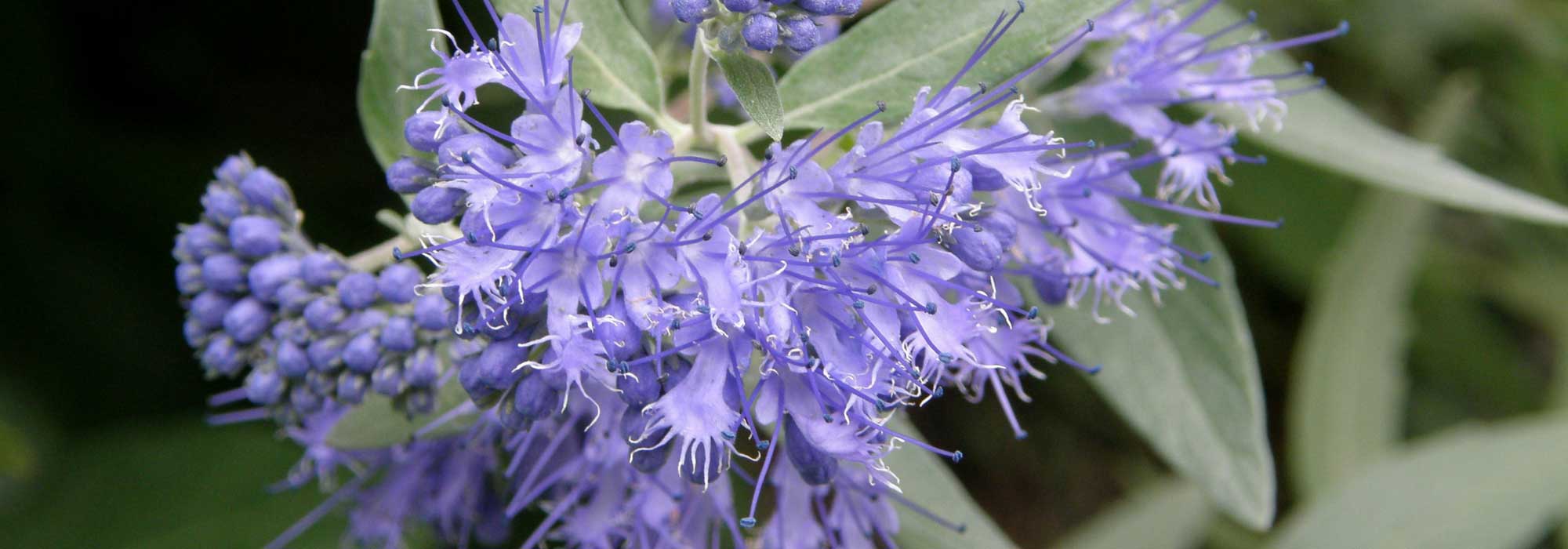
Caryopteris, bluebeard: planting, pruning and care
Contents
Caryopteris in a nutshell
- Caryopteris is a small shrub that thrives in full sun, overflowing with flowers at the end of summer
- It blooms continuously from August to October in the form of clusters of flowers, most often blue, sometimes pink
- Its deciduous grey-green foliage, or variegated with golden yellow, is remarkable and aromatic when crushed
- It is a sun-loving shrub that prefers well-drained, even dry soil, hardy and easy to grow under these conditions
- Versatile, it can be used in a perennial border, in rockeries, as a small hedge, or in a pot on a very sunny terrace
A word from our expert
The Caryopteris, also known as “Blue Beard” or Blue Spiraea, is a graceful bush appreciated for its flowering in endless azure shades at the end of the season and for its aromatic silver, variegated, or golden foliage that releases a fragrance when crushed. Its relatively late flowering follows the summer blooms. The cultivars of Caryopteris clandonensis are primarily encountered, which is a beautiful hybrid obtained through cross-breeding with the less commonly grown species Caryopteris incana in our gardens.
From Caryopteris ‘Heavenly Blue’ with its countless small flowers of the most intense blue observed in Blue Spiraeas to Caryopteris x clandonensis ‘Grand bleu‘ with its royal blue flowering, this small bush brings a touch of freshness right up to the gates of winter in English gardens, country gardens, and city gardens.
Of modest size, its slender stems rarely rise above 1.50 m in height.
Quite hardy and undemanding, it is easy to grow in a sunny location sheltered from strong winds and in deep, relatively dry, and very well-drained soil. Apart from a severe pruning each year, it requires no maintenance!
Find the Caryopteris you are missing in our unique collection and plant this voluptuous and elegant bush in a flowering hedge, in a flowerbed, or even on a sunny terrace!
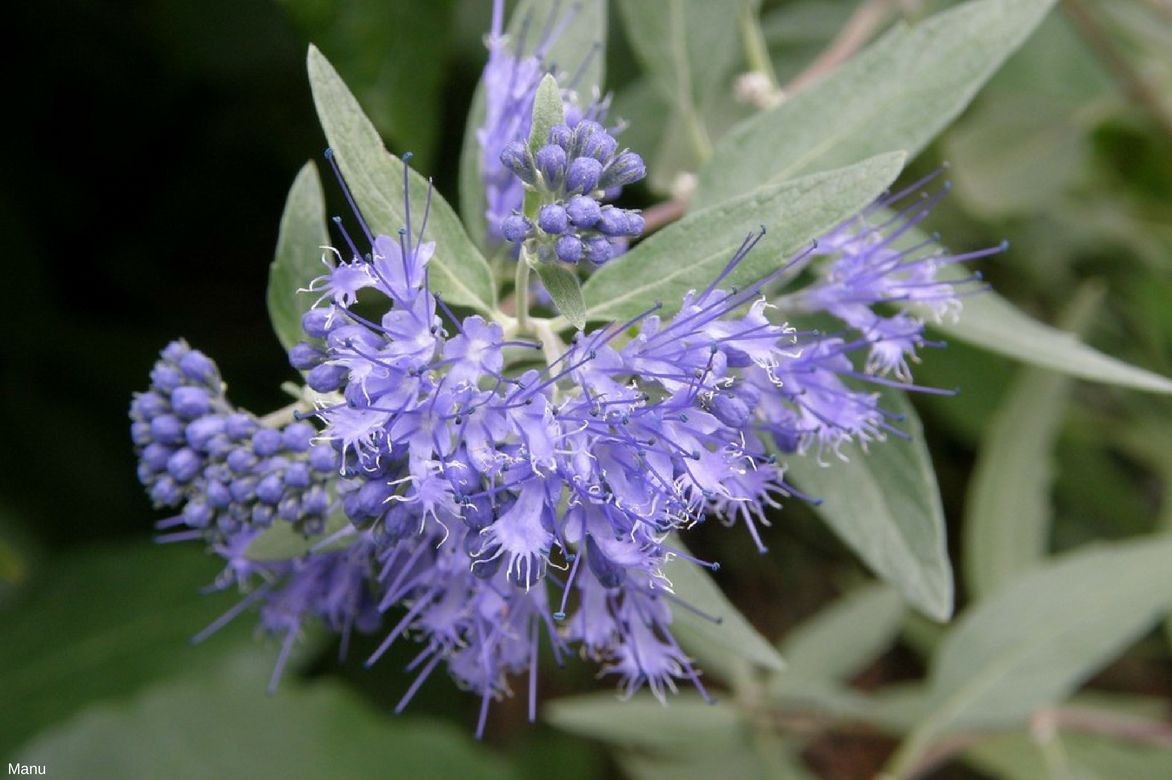
Inflorescence of Blue Beard or Blue Spiraea.
Description and botany
Botanical data
- Latin name Caryopteris
- Family Verbenaceae
- Common name Blue beard, Blue spiraea
- Flowering August to October
- Height 0.45 to 1.50 m
- Exposure Sun
- Soil type Stony, calcareous, neutral, well-drained
- Hardiness -15°C-20°C
Le Caryopteris, sometimes called Blue beard or Blue spiraea is a small deciduous bush from the verbena family that grows in the forests and on the dry, warm slopes of the Himalayas and the mountains of Asia, particularly in Mongolia and northern China.
The genus includes 6 species, but the one most commonly found in our gardens is Caryopteris x clandonensis, one of the hybrids obtained by cross-breeding the species Caryopteris incana and the hardier Caryopteris mongolica. It has given rise to numerous blue cultivars such as ‘Heavenly Blue’ and a few pink varieties like ‘Pink Perfection’.
The Caryopteris forms a small bush, rounded, bushy, and well-branched, growing to 45 cm to 1.50 m depending on the variety and often wider than tall. Its habit is naturally almost wild. Its growth is regular to fast, but it has a rather short lifespan that can be extended by annual severe pruning.
The Caryopteris is distinguished by its ornamental foliage that is also pleasantly aromatic when crushed. In spring, small deciduous leaves, simple, entire, or irregularly dentate, arranged oppositely on the long green stems, appear. The branches take on a purplish-red hue at the tips.
Oval and lanceolate, they measure 3 to 7 cm long, grey-green, silvery to dark green matte, and mostly downy on the underside. Some hybrids like Caryopteris (x) clandonensis ‘Hint of Gold’ offer particularly bright variegated foliage, grey-green edged with bright yellow or golden (‘Worcester Gold’).
When crushed, they release, depending on the variety, a very characteristic resinous smell of turpentine or a fragrance with notes of anise and lavender. They form a beautiful backdrop for the late summer flowering, which is often an intense blue of remarkable delicacy.

The inflorescences can be of various colours and shapes: Caryopteris clandonensis ‘Heavenly Blue’, Caryopteris ‘Pink Perfection’, Caryopteris divaricata (also exists with variegated foliage ‘Electrum’), Caryopteris clandonensis ‘White Surprise’.
From August to October, the airy inflorescences grouped in cymes or panicles at the axil of the leaves or at the tips of the year’s branches emerge. They cover the entire vegetation with wide, dense bouquets composed of countless small tubular flowers with 5 petals measuring 3 to 8 mm in diameter, arranged in whorls. Their 4 prominent and silky stamens emerge from the heart of the corolla, gracefully arching towards the ground, giving the whole a powdery appearance.
In a beautiful blue, more or less intense depending on the varieties, ranging from quite bright lavender blue to blue-mauve, they are more rarely pale pink.
The branches of the Caryopteris will make very lovely natural and fresh bouquets that hold well in a vase.
Not fragrant, this flowering that lasts until early autumn is nevertheless particularly melliferous and nectariferous. It is highly appreciated by beekeepers. The flowers attract many butterflies and bees that extract a delicate honey with hints of lavender.
Easy to grow, resistant to both cold and drought as well as diseases, the Caryopteris will be hardy down to -15°C -20°C in well-drained soil, even dry, stony, or sandy, quite deep. It will grow easily in the sun in a border, a large rockery, or in a small hedge that is not too windy.

The foliage of some Caryopteris is very decorative: Caryopteris clandonensis ‘Heavenly Blue’, Caryopteris clandonensis ‘White Surprise’, Caryopteris ‘Hint of Gold’, Caryopteris ‘Summer Sorbet’.
Main species and varieties
There are 6 species of Caryopteris, but it is Caryopteris x clandonensis that is the most commonly cultivated hybrid in our gardens. This hybrid declinates the most varieties with colours ranging from royal blue to mauve blue and including pale pink.
There are about 16 varieties, including ‘Heavenly Blue’ and ‘Grand bleu‘. The Blue Beard is also distinguished by the colour of its foliage, which is mostly silver. Some cultivars offer a beautiful variegated almond green foliage edged in yellow or cream. Others have remarkably bright golden foliage.

Caryopteris clandonensis Heavenly Blue - Bluebeard
- Flowering time September to November
- Height at maturity 80 cm
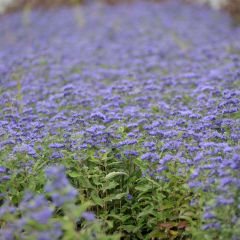
Caryopteris clandonensis Grand Bleu - Bluebeard
- Flowering time September to November
- Height at maturity 1 m
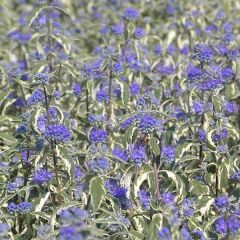
Caryopteris clandonensis White Surprise - Bluebeard
- Flowering time September to November
- Height at maturity 1 m
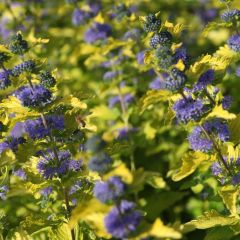
Caryopteris clandonensis Hint of Gold - Bluebeard
- Flowering time August to October
- Height at maturity 1 m
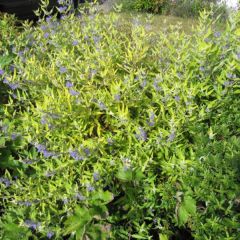
Caryopteris clandonensis Worcester Gold - Bluebeard
- Flowering time September to November
- Height at maturity 1 m
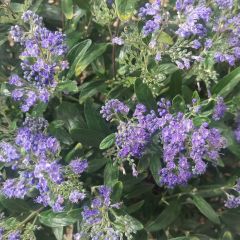
Caryopteris clandonensis Petit Bleu - Bluebeard
- Flowering time September to November
- Height at maturity 60 cm
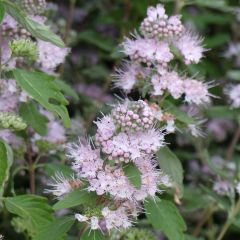
Caryopteris clandonensis Pink Perfection - Bluebeard
- Flowering time August to October
- Height at maturity 90 cm
Discover other Caryopteris
View all →Available in 2 sizes
Available in 0 sizes
Available in 1 sizes
Available in 1 sizes
Available in 1 sizes
Available in 1 sizes
Available in 3 sizes
Available in 1 sizes
Available in 3 sizes
Available in 1 sizes
Planting
Where to Plant Caryopteris or Blue Beard?
Once well established in well-drained soil, Caryopteris can withstand winter temperatures down to -12 to -20 °C and adapts well to summer drought. It is not as tender as often claimed and will thrive in all regions of France.
It should be planted in a very sunny location sheltered from cold, damp winds. Position it against a south-facing wall with good mulch in areas where summers are cool and winter temperatures drop below -15°C.
It prefers a light, well-drained, ordinary to neutral soil, preferably stony or sandy. It is a good bush for calcareous soil. However, it will perform best in deep, fairly humus-bearing soil. It is easy to grow in well-draining soil but fears excess moisture and waterlogged soils in winter, which severely affect its hardiness.
Caryopteris finds its place in all natural and wild gardens, in English cottage gardens, and even in city gardens on terraces, creating lovely focal points and vibrant scenes at the end of summer. Surround it well, as once its flowering is over and its beautiful foliage has fallen, it quietly returns to anonymity, becoming rather ordinary.
Its modest dimensions, with heights ranging from 50 cm for the smallest to 1.50 m for the largest, make it indispensable both in pots and in the front or second row of a perennial bed, in a rockery, or in a low hedge.
When to Plant Caryopteris?
Caryopteris is preferably planted in spring from late February to early March, and until May, in any case after the last severe frosts. Autumn planting is in September to October, avoiding periods of extreme heat.
How to Plant Caryopteris?
Generally wider than tall, Caryopteris needs enough space to develop and well-loosened soil to root. It will appreciate a good supply of compost and thorough watering at planting. Space the plants 50 cm to 1 metre apart. Plant in groups of 3 at the foot of a perpetual rose, for example, for a beautiful effect at the end of the season!
- Dig a hole twice as wide and deep as the root ball
- In wet soils, spread a layer of stones or gravel 30 cm thick at the bottom of the hole
- Amend with compost and a few handfuls of organic fertiliser
- Lighten with a spadeful of river sand
- Throw a spadeful of enriched soil into the hole and place the bush in the centre without burying the collar
- Fill in and lightly compact around the base of the bush, then water
How to Plant Caryopteris in a Pot?
Compact varieties of Blue Beard, such as ‘Petit Bleu’, will make a statement in a large pot on the terrace where their aromatic foliage will release their intense balsamic fragrance at the slightest touch.
Choose a large square pot (minimum 40 cm deep and wide) to allow its roots to develop properly.
- Ensure good drainage with clay balls or pumice
- Plant in good potting soil
- Water regularly in summer without ever drowning the plant
- Repot every two years into a larger container

The flowers of the blue spiraea are melliferous.
Read also
How to take cuttings from Caryopteris?Maintenance and care
Hardy often down to -15°C, resistant to drought, once established, the Blue Beard requires very little maintenance to flower abundantly year after year and grow on its own.
Water regularly during the first two summers. After that, occasional watering in summer will suffice; this bush will be content with rainwater!
Before winter, the bush needs a thick mulch of dried leaves to properly protect its base from severe cold. In spring, spread a little compost at its base; in this case, it will do without fertiliser: it is an undemanding plant that prefers moderately fertile soils.
In pots, water more frequently while allowing the soil to dry out well between waterings and provide a flowering plant fertiliser in spring. In case of severe frosts forecasted, you can move it to a sheltered spot in winter.
Pruning a Caryopteris
Caryopteris requires a good severe annual pruning. This pruning helps to maintain a dense habit, limit the height of the bush if necessary, and ensure it remains highly floriferous. It will also withstand the ravages of time better: pruning will prolong its lifespan and strengthen it.
- Using shears, prune the branches by half or even by 2/3 at the beginning of spring around March-April
- Remove dead wood and unnecessary branches that disrupt the silhouette
Enemies and potential diseases of the Bluebeard
Caryopteris is a robust plant that is not afraid of much except for the so-called “mosaic” virus, which causes yellowish spots on its leaves. The best course of action is to uproot and burn the affected plant before it spreads, as unfortunately, there is no miracle solution.
Multiplication of the Bluebeard
Caryopteris is easily propagated by cuttings in July-August.
How to take cuttings?
- Take lateral shoots 10 to 20 cm long
- Remove the lower leaves, keeping only two pairs of upper leaves
- Cut them in half just below a node
- Plant them halfway in small pots filled with a light mixture of sand and turf
- Keep the substrate just moist, then place under a frame all winter without direct sunlight
- Transplant the cuttings into the ground as soon as the following spring
→ Learn more about propagation by cuttings of Caryopteris with Ingrid’s tutorial
Associating Caryopteris in the garden
With its unique blue flowering, Caryopteris or ‘Blue Beard’ is perfect for transforming any sunny nook into a heavenly symphony! In autumn, the intense blue of its flowers sets it apart from other plants and bushes.
It combines charm and simplicity, and with its natural allure, it finds its place in all naturalistic or wild gardens, country gardens, or city gardens, blending into the mass with a rare sensuality.
Pair it with other late-flowering shrubs or autumn foliage plants like Japanese maples and euonymus, which will extend the pleasures of summer. Their blue flowers mixed with the colourful late-season foliage will bring a touch of freshness to a large country border, a small flowering hedge, in pots, as well as in bouquets.
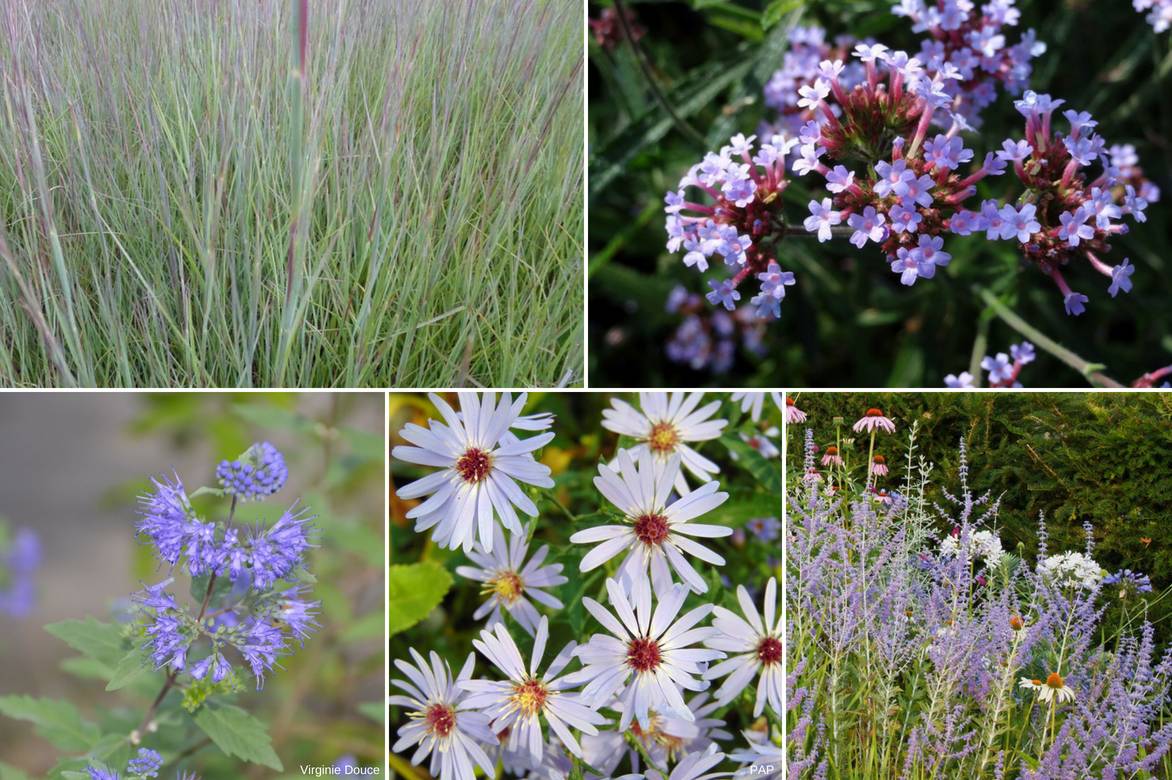
An example of a blue hue association: Schizachyrium scoparium ‘Prairie Blues’, Verbena bonariensis, Caryopteris clandonensis ‘Grand Bleu’, Aster cordifolius ‘Blue Heaven’, Perovskia atriplicifolia ‘Blue Spire’.
In a perennial border, play with shades of blue by placing Caryopteris next to Siberian sage (Perovskia atriplicifolia), which flowers at the same time, shrubby sage, Verbena bonariensis, Elsholtzia stauntonii, asters in similar azure tones, and grasses like fescues. It also pairs well at the base of Ceanothus, a blue Hibiscus, buddleias, and will stand out with dwarf blue conifers.
The Caryopteris with pink spikes harmonises well with pink phlox, dwarf dahlias, and Epilobium.
Autumn daisies, echinaceas, Helianthus, Helenium, Heliopsis, sedums, and evening primroses in golden yellow tones will accompany it until the last embers of autumn. It is also the perfect companion for potentillas, coronillas, or yellow perpetual roses.
The blue spiraeas with golden foliage (‘Hint of Gold’) will keep company with Choisya ‘Sundance’, golden grasses, or even Lysimachia (Lysimachia nummularia ‘Aurea’, ‘Alexander’).
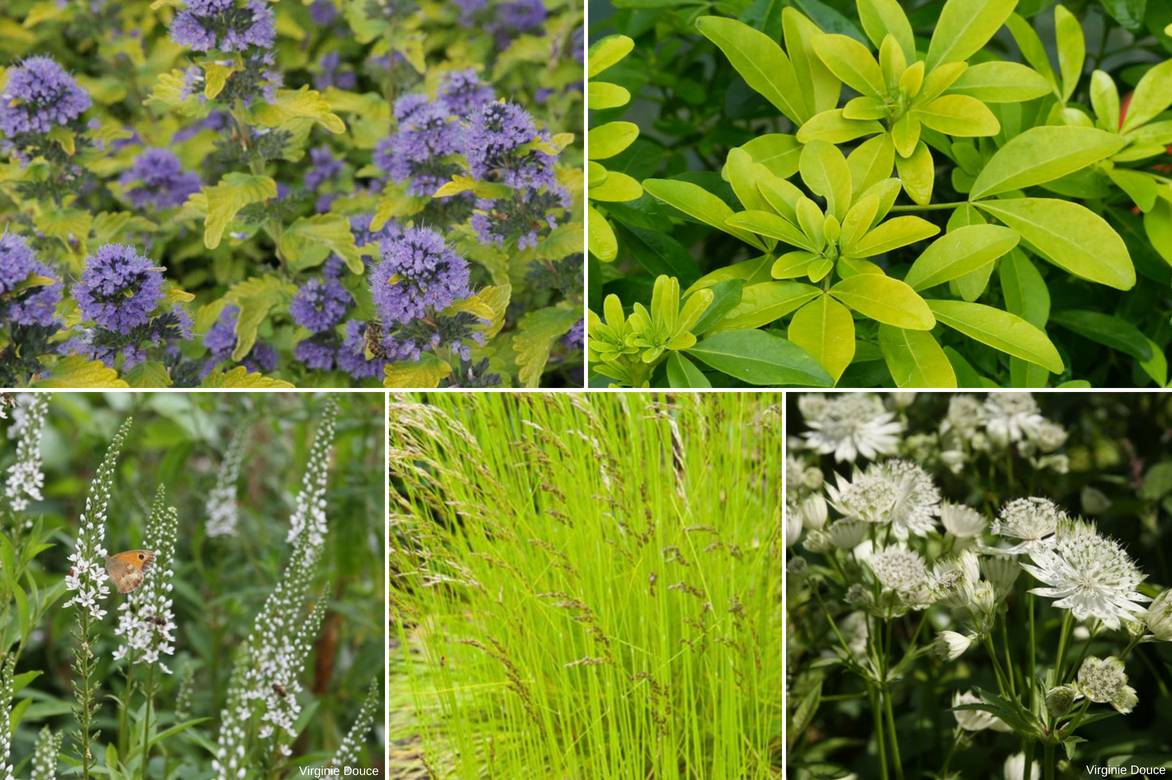
An example of a bright association: Caryopteris ‘Hint of Gold’, Choisya ternata ‘Sundance’, Lysimachia fortunei, Deschampsia flexuosa ‘Tatra Gold’, Astrantia major ‘Shaggy’.
In a beautiful pot, it will neighbour with lavenders, anthemis, or asters.
Useful resources
- The most beautiful and rare Caryopteris are with us!
- Discover 7 ideas to pair Caryopteris
- Do you love blue-flowering bushes? Check out our article: 8 blue-flowering bushes you must have in your garden
- Blue Beard is a plant for dry soil; what undemanding companions can you pair it with in the garden? All our solutions for a dry garden
- Blue and yellow, a perfect contrast!
- Our advice sheet: choosing a Caryopteris
- Our advice sheet: Caryopteris: the most beautiful varieties
- Our tutorials: How to propagate Caryopteris? and When and how to prune a Caryopteris?
- Subscribe!
- Contents
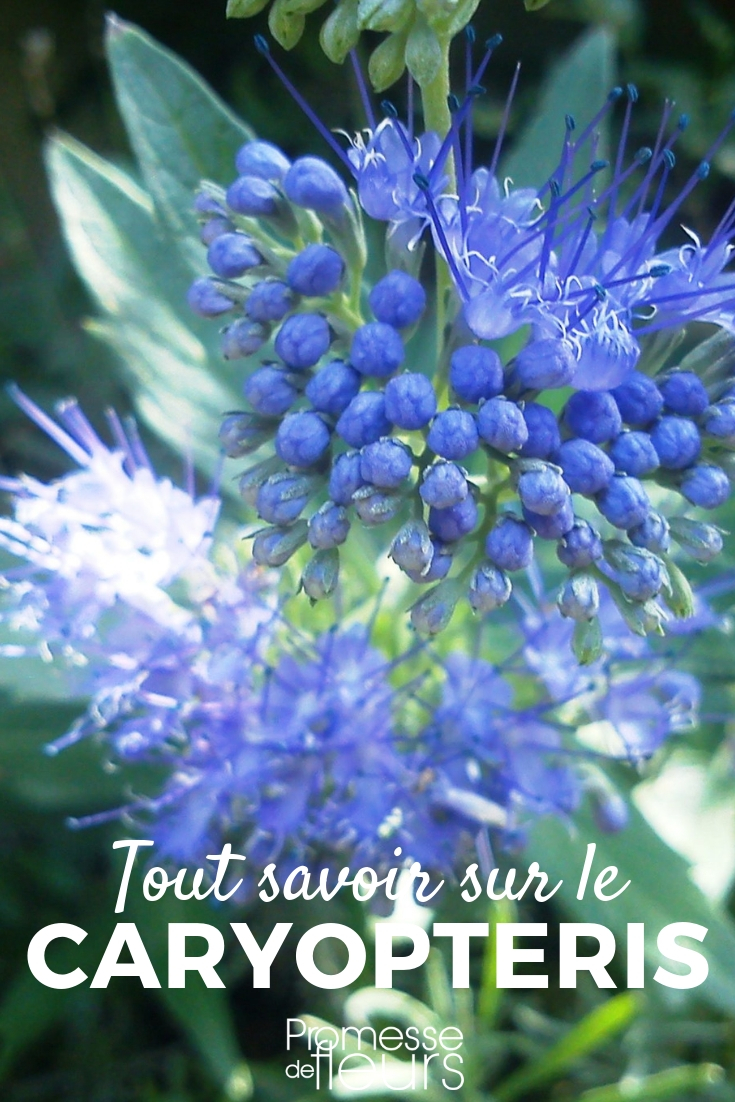
































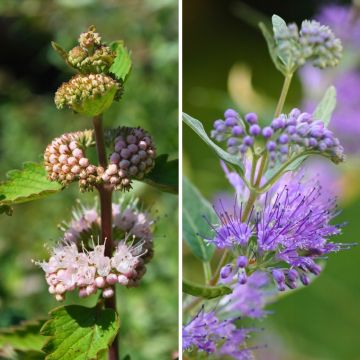
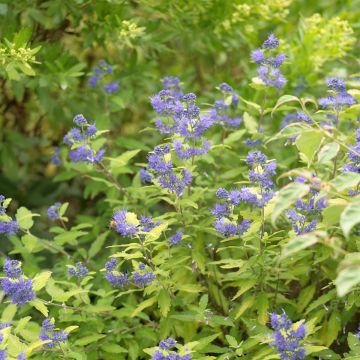
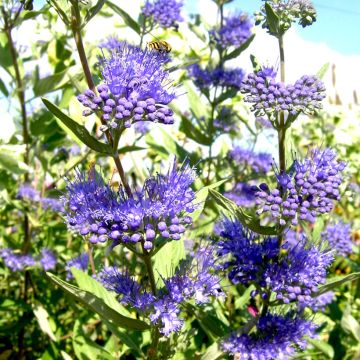

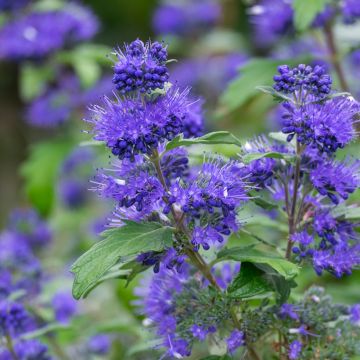
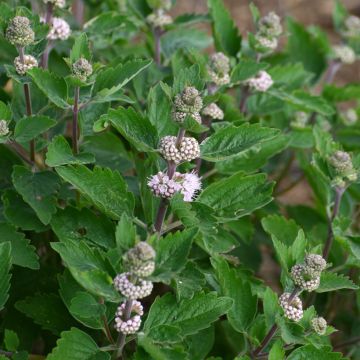
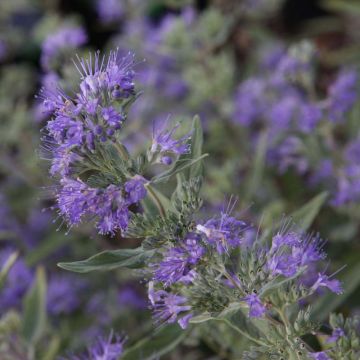
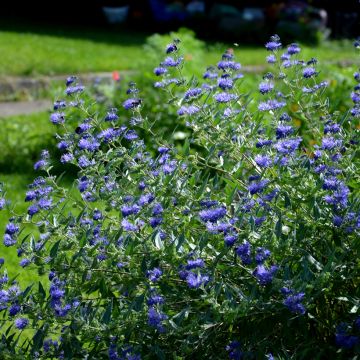
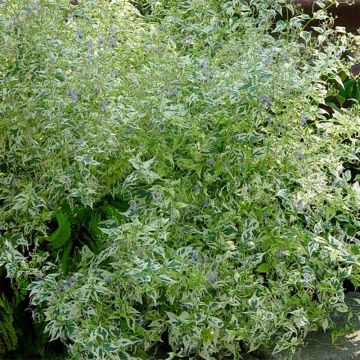
Comments